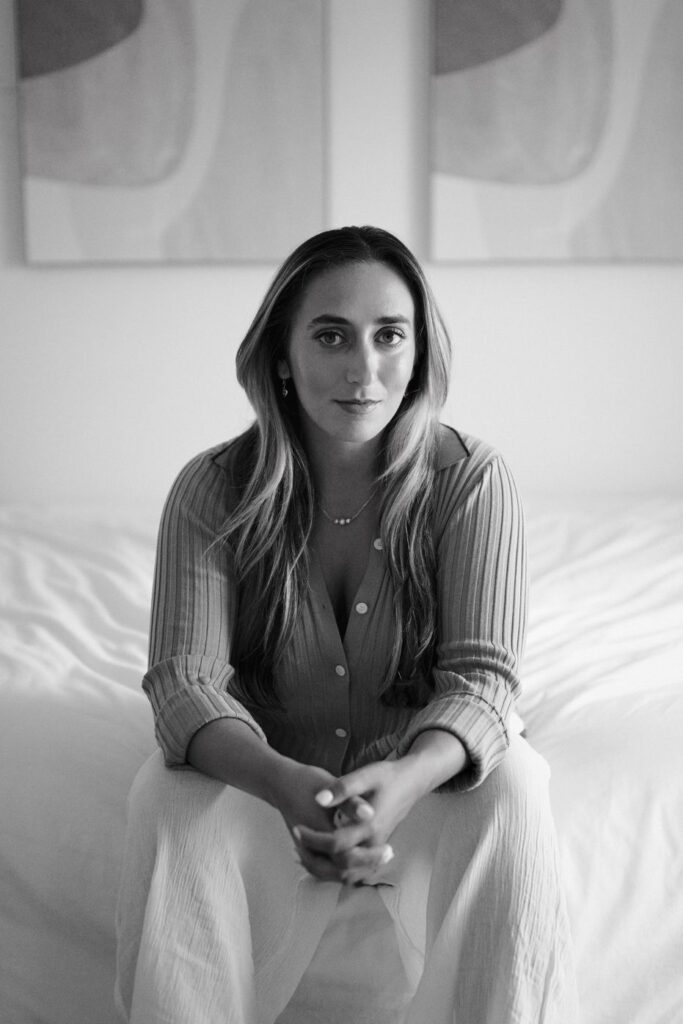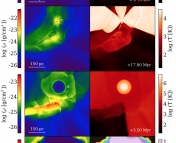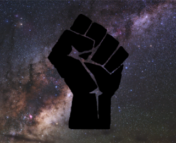By Lucas Brown and Emma Clarke
Content Warning: illness/surgery

Sarafina El-Badry Nance is an Egyptian-American astrophysicist and a PhD candidate at UC Berkeley as well as an analog astronaut, science communicator, women’s health advocate, Sports Illustrated swimsuit model, and author of the recently released Starstruck–her debut memoir. We sat down with Sarafina to talk about her book, astrophysics research, and more!
Exploding Stars and Research on Mars
Over the past several years, in the moments between sharing her love of science online, giving interviews, and writing her memoir, Nance has been working on another big project: her PhD. Since her undergraduate years, she’s been researching the deaths of massive stars, and that interest has carried through to the present in the form of her PhD research at UC Berkeley, although now with a focus on what they can tell us about the history of the universe.
“I study exploding stars… specifically massive stars—core collapse supernovae… to try to measure the rate of the expansion of the universe,” she told us. While these two concepts may sound disparate, supernovae have long been used to get precise constraints on cosmology. “Historically cosmology has been done with Type Ia [supernovae]… they all explode with the same luminosities, so they’re [called] standard candles.” This consistency allows astronomers to precisely infer their distance from us, which in turn allows for precise measurements of the large-scale dynamics of the universe. On the other hand, Type II supernovae (a type of core collapse supernovae) can vary widely in the amount of light they give off. Despite this variation, it is thought that with sufficient theoretical work, the luminosities of Type II supernovae can be calculated based on the properties of the stars that collapse to form them. As Nance puts it, “While they’re not standard candles, they can be standardized—and that’s what we’re working on.”
Nance has also gone “interplanetary” with her work. In 2021, she participated in the HI-SEAS analog astronaut project, which simulates what it would be like to live and conduct research on the Moon or Mars. For two weeks, Nance and four other crew members were isolated in an enclosed habitat situated on the remote and Mars-like Mauna Loa volcano in Hawaii. During the mission, Nance studied the composition of volcanic rocks to learn more about the type of supernova or supernova ‘group’ that could be responsible for the formation of our solar system. Mauna Loa is an interesting place to investigate this question because it provides samples of some of the “oldest, untouched, and uncontaminated” rocks we have access to in the solar system. In the future, studying the composition of rocks on Mars that are uncontaminated by humans might show something even more interesting.
When Nance was younger, “becoming an astronaut never seemed like it was something on the table,” but later in grad school she realized that “this is something people apply for and might one day be a possibility for someone like me.” She began the process of applying and pursuing relevant training, such as obtaining a scuba license. Looking back on the mission, she explained that her experience as an analog astronaut made her “even more excited” about the possibility of becoming an astronaut. Although she has no immediate plans to become an astronaut, she says that she “would love to be an astronaut one day” and will “keep throwing [her] hat into the ring.”
Writing a Memoir

Earlier in grad school, Nance started to talk about astronomy online while studying for exams. Eventually, while recovering from her mastectomy, she felt that she “couldn’t be honest in the way [she] wanted to show up online without talking about [her series of surgeries].” After sharing more about her personal experiences online, Nance was struck by the response and how she was able to connect with people. She felt it was important to share more of her story as she still felt out of place in much of her day-to-day life. She wanted some way to “share that with others and hopefully provide a sense of belonging for readers that might have also felt that way in whatever fields they’re in.” Writing a memoir “felt like my opportunity to really share my full humanness with people,” explained Nance.
Following the decision to share her experiences in a book, Nance was “really excited to write.” The journey, from the proposal process to working with the editor to flesh out each chapter to lawyer review, production, and publicity, has been about three years long. This process was happening on top of everything else going on in Nance’s life, including working on her PhD. “There were moments when everything was balanced in a beautiful way, then everything would fall and I would be behind in one way or another,” she shared about the process. Fortunately, she had a good support system, including an understanding advisor, throughout. Nance sums up the writing process as being “really cathartic, but hard, and wonderful.”
Something that helped Nance a lot with writing was reading. “I read a lot during this process,” she shared. “It was so helpful to absorb as many words as possible and think about the way people communicate things.” Nance loves to read, and always has. “Books were my friends as a kid,” she explains. That is one reason why she jumped at the opportunity to work on a kids book, which she was approached to do while writing the proposal for her memoir. The book is a short, illustrated introduction to astronomy. Nance worked with the illustrator not only to portray facts about astronomy, but also to “find ways to represent kids of different identities,” something which was really important to her. Astronomy books inspired her as a kid, especially the pictures, so working on this book was “a really exciting opportunity to give that to others.”
Nowadays, Nance continues to be an avid reader. For the record, “I do read other things besides Harry Potter*,” she proclaims. Mostly she turns to fiction, with fantasy perhaps her top genre. “I like stories that explore what it means to be human,” she explained. Which is “something I ended up investigating in my own book.”
Science Communication, Social Media, and Sagan
Despite not having much writing experience prior to Starstruck, Nance has been doing science communication in other forms for years now, which is evident in the clarity with which she explains scientific concepts at the start of each chapter. Beyond explaining very complex topics in an accessible way, these segments are written with humanity in mind first and foremost, centering the relation between big ideas in physics and the day-to-day of human life. It’s no surprise that Carl Sagan has been a huge influence on her endeavors in science communication:
“My number one [science communicator] will always and forever be Carl Sagan. I think he was incredibly poetic and lyrical, and that’s something that I admire deeply… it’s a way to sort of transcend these barriers between the technical and the magic of what we all learn when we study astronomy or any science field.” Thinking about her other favorites in the physics communication world, Nance praised theoretical cosmologist and author Katie Mack, as well as theoretical physicist and philosopher Sean Carroll. When asked about how it felt to receive a highly-praising blurb from Carroll for her book (which includes the pronouncement that Starstruck is “The best book you will ever read about growing up to be a scientist”), Nance said bluntly that it was “Freaking unbelievable… I cried a lot when I got that, it was really surreal.”
Turning the conversation to Nance’s own career as a science communicator, Nance recalled the shock she felt when her Twitter began to attract followers: “I was really not expecting it to go anywhere,” she told us. To her surprise, what started as an outlet for sharing her experience studying in graduate school quickly made her into a prominent social media personality. “It wasn’t really about the reception, it was more about me performing the exercise, and then I was flabbergasted when people were like ‘this is cool!’ and I was like ‘I know it is cool!’ It was validating, and provided the fuel for the fire for me to keep going.”
Reflecting on science communication in the age of social media more broadly, she sees online content as providing a number of uniquely positive opportunities, but within the confines of an overall media landscape that can be difficult to navigate.
“I think being online is a really powerful way of reaching audiences that maybe you wouldn’t have reached otherwise.” But conversely, Nance says, “It’s hard—every platform has its problems.” For example, while platforms like Twitter can facilitate genuine connections, it can be hard to reach new audiences. On the other hand, video platforms like TikTok can have a larger reach but it can be difficult to engage with the audience. Regardless, Nance enjoys the convenience of short-form video content: “I could literally be on a walk and be like ‘I want to talk about the expanding universe’ and then it’s done… it’s much more accessible I think from a creator standpoint.” Going forward, Nance hopes to continue to engage in science communication. In particular, she hopes to engage with more people outside of the online physics and astronomy ecosystem, as she feels that she sometimes ends up “talking about science and astronomy… to the same audiences that are also talking about it” on social media, which can feel “a little bit echo-chambery.”
“I am constantly trying to think of ways to break out of that, and be more accessible, be more intentional about what I’m saying, trying to be a better communicator. Part of that is trying to find more interesting or different ways of explaining concepts or material. I find that really exciting and energizing and worthwhile.” Whatever form that next project comes in, whether it be another book or more videos or something completely different, Nance hopes to continue “…to weave together the science and the human. That’s what’s interesting to me right now.”
To learn more about Nance’s memoir, check out Astrobites’ review of Starstruck.
*Sarafina would like to take this opportunity to state that she does not agree with or endorse JK Rowling, who in recent years has publicly shared harmful and transphobic opinions.
Astrobite edited by Katya Gozman and Sabina Sagynbayeva
Featured image credit: Penguin Random House
Thanks to Sarafina Nance for taking the time for this interview, and to Sarah Thegeby and Dutton Books / Penguin Random House for providing an advance copy of the book.



